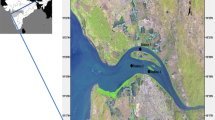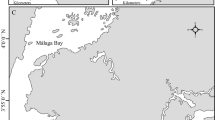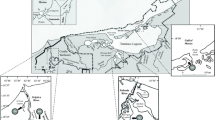Abstract
The isotopic composition of carbon and nitrogen of sources and consumers and the mixing model stable isotope analysis in R (SIAR) were used to understand the trophic structure to identify the main carbon sources in the food web of a highly humid riverine mangrove system on the Pacific coast of Colombia. The δ13C values of carbon sources varied from − 30.6 to − 26.9‰. Consumers were separated into invertebrates (with δ13C mean values from − 24.8 ± 0.3‰ to − 15.7 ± 0.7‰) and fish (with δ13C mean values from − 21.2 ± 1.3‰ to − 17.2 ± 0.9‰). Benthic mobile invertebrates generally had depleted δ13C values related to different trophic pathways to those of filter feeders and fish (with more enriched δ13C values). In agreement with similar studies in estuarine macro-tidal areas (e.g., Brazil and Panamanian Pacific), the large range in δ13C values for consumers may indicate that different carbon sources are important for the analyzed food web. In general, fish exhibited greater nitrogen values than invertebrates, indicating higher trophic levels. Among all consumers, with some exceptions, δ15N values correctly reflected the trophic levels, as species from lower trophic levels had lower δ15N than species from higher trophic levels. The trophic length of the food web was estimated from producers to higher consumers based on δ15N values. Taking into account a nitrogen trophic fractionation value of 3.4‰, the studied system exhibited a food web with four trophic levels. Based on the distribution of consumer trophic guilds in the δ13C-δ15N plane and the mixing model results, we recognized that at least two main pathways are present in the system to support the community.



Similar content being viewed by others
References
Abrantes, K., and M. Sheaves. 2009. Food web structure in a near-pristine mangrove area of the Australian wet tropics. Estuarine Coastal and Shelf Science 82 (4): 597–607. https://doi.org/10.1016/j.ecss.2009.02.021.
Abrantes, K., and M. Sheaves. 2010. Use of a δ13C – δ15N relationship to determine animal trophic positions in a tropical Australian estuarine wetland. Austral Ecology 35 (1): 96–103. https://doi.org/10.1111/j.1442-9993.2009.02017.x.
Alongi, D.M. 2014. Carbon cycling and storage in mangrove forests. Annual Review of Marine Science 6 (1): 195–219. https://doi.org/10.1146/annurev-marine-010213-135020.
Bouillon, S., A.V. Raman, P. Dauby, and F. Dehairs. 2002. Carbon and nitrogen stable isotope ratios of subtidal benthic invertebrates in an estuarine mangrove ecosystem (Andhra Pradesh, India). Estuarine, Coastal and Shelf Science 54 (5): 901–913. https://doi.org/10.1006/ecss.2001.0864.
Bouillon, S., R. Connolly, and S.Y. Lee. 2008. Organic matter exchange and cycling in mangrove ecosystems: Recent insights from stable isotope studies. Journal of Sea Research 59 (1-2): 44–58. https://doi.org/10.1016/j.seares.2007.05.001.
Bouillon, S., R.M. Connolly, and D.P. Gillikin. 2011. Use of stable isotopes to understand food webs and ecosystem functioning in estuaries. In Treatise on estuarine and coastal science, ed. E. Wolanski and D.S. McLusky, vol. 7, 143–173. Waltham: Academic Press. https://doi.org/10.1016/B978-0-12-374711-2.00711-7.
Bouillon, S., A. Yambéle, R.G.M. Spencer, D.P. Gillikin, P.J. Hernes, J. Six, R. Merckx, and A.V. Borges. 2012. Organic matter sources, fluxes and greenhouse gas exchange in the Oubangui River (Congo River basin). Biogeosciences 9 (6): 2045–2062. https://doi.org/10.5194/bg-9-2045-2012.
Brugnoli, E., and M. Laureti. 1991. Effects of salinity on stomatal conductance, photosynthetic capacity, and carbon isotope discrimination of salt tolerant (Gossypium hirsutum L.) and salt-sensitive (Phaseolus vulgaris L.) C3 non-halophytes. Plant Physiology 95 (2): 628–635. https://doi.org/10.1104/pp.95.2.628.
Cantera, J.R., and J.F. Blanco. 2001. The estuary ecosystem of Buenaventura Bay, Colombia. In Coastal marine ecosystems of Latin America, ed. U. Seeliger and B. Kjerfve, 265–280. Berlin: Springer Berlin Heidelberg. https://doi.org/10.1007/978-3-662-04482-7_19.
Cantera, J., and J. Restrepo. 1995. Delta del Río San Juan. Bahías de Málaga y Buenaventura, Pacífico colombiano. Tomo I. Santiago de Cali: Centro editorial Universidad del Valle.
Cantera, J.R., B.A. Thomassin, and P.M. Arnaud. 1999. Faunal zonation and assemblages in the Pacific Colombian mangroves. Hydrobiologia 413: 17–33. https://doi.org/10.1023/A:1003890826741.
Castellanos-Galindo, G.A., and U. Krumme. 2013. Tidal, diel and seasonal effects on intertidal mangrove fish in a high-rainfall area of the tropical eastern Pacific. Marine Ecology Progress Series 494: 249–265. https://doi.org/10.3354/meps10512.
Castellanos-Galindo, G.A., J. Cantera, U. Saint-Paul, and D. Ferrol-Schulte. 2015. Threats to mangrove social-ecological systems in the most luxuriant coastal forests of the Neotropics. Biodiversity and Conservation 24 (3): 701–704. https://doi.org/10.1007/s10531-014-0827-y.
Christensen, J.T., P.G. Sauriau, P. Richard, and P.D. Jensen. 2001. Diet in mangrove snails: Preliminary data on gut contents and stable isotope analysis. Journal of Shellfish Research 20: 423–426.
France, R. 1998. Estimating the assimilation of mangrove detritus by fiddler crabs in Laguna Joyuda, Puerto Rico, using dual stable isotopes. Journal of Tropical Ecology 14 (4): 413–425. https://doi.org/10.1017/S0266467498000315.
Fry, B., and T.J. Smith III. 2002. Stable isotope studies of red mangroves and filter feeders from the Shark River estuary, Florida. Bulletin of Marine Science 70: 871–890.
Giarrizzo, T., R. Schwamborn, and U. Saint-Paul. 2011. Utilization of carbon sources in a northern Brazilian mangrove ecosystem. Estuarine, Coastal and Shelf Science 95 (4): 447–457. https://doi.org/10.1016/j.ecss.2011.10.018.
Hogarth, P. 2015. The biology of mangroves and seagrasses. Oxford: Oxford University Press. https://doi.org/10.1093/acprof:oso/9780198716549.001.0001.
Lee, O.H.K., G.A. Williams, and K.D. Hyde. 2001. The diets of Littoraria ardouiniana and L. melanostoma in Hong Kong mangroves. Journal of the Marine Biological Association of the U.K. 81 (06): 967–973. https://doi.org/10.1017/S002531540100491X.
Lucero, C., J.R. Cantera, and I. Romero. 2006. Variability of macrobenthic assemblages under abnormal climatic conditions in a small scale tropical estuary. Estuarine, Coastal and Shelf Science 68 (1-2): 17–26. https://doi.org/10.1016/j.ecss.2005.11.037.
Lugo, A.E., and S. Snedaker. 1974. The ecology of mangroves. Annual Review of Ecology and Systematics 5 (1): 39–64. https://doi.org/10.1146/annurev.es.05.110174.000351.
Martínez, J.O., and E. López-Ramos. 2011. High-resolution seismic stratigraphy of the late Neogene of the central sector of the Colombian Pacific continental shelf: A seismic expression of an active continental margin. Journal of South American Earth Sciences 31 (1): 28–44. https://doi.org/10.1016/j.jsames.2010.09.003.
Medina, E., and M. Francisco. 1997. Osmolality and δ13C of leaf tissues of mangrove species from environments of constrasting rainfall and salinity. Estuarine, Coastal and Shelf Science 45 (3): 337–334. https://doi.org/10.1006/ecss.1996.0188.
Michener, R., and K. Lajtha. 2007. Stable isotopes in ecology and environmental science. 2nd ed. Oxford: Blackwell publishing. https://doi.org/10.1002/9780470691854.
Parnell, A.C., R. Inger, S. Bearhop, and A.L. Jackson. 2010. Source partitioning using stable isotopes: Co** with too much variation. PLoS One 5: 1–5.
Peterson, B.J., and B. Fry. 1987. Stable isotopes in ecosystem studies. Annual Review of Ecology and Systematics 18 (1): 293–320. https://doi.org/10.1146/annurev.es.18.110187.001453.
Post, D.M. 2002. Using stable isotopes to estimate trophic position: Models, methods, and assumptions. Ecology 83 (3): 703–718. https://doi.org/10.1890/0012-9658(2002)083[0703:USITET]2.0.CO;2.
Post, D.M., C.A. Layman, D.A. Arrington, G. Takimoto, J. Quattrochi, and C.G. Montaña. 2007. Getting to the fat of the matter: Models, methods and assumptions for dealing with lipids in stable isotope analyses. Oecologia 152 (1): 179–189. https://doi.org/10.1007/s00442-006-0630-x.
Price, G.D., M.R. Badger, F.J. Woodger, and B.M. Long. 2008. Advances in understanding the cyanobacterial CO2-concentrating-mechanism (CCM): Functional components, ci transporters, diversity, genetic regulation and prospects for engineering into plants. Journal of Experimental Botany 59 (7): 1441–1461. https://doi.org/10.1093/jxb/erm112.
Restrepo, J.D., B. Kjerfve, I.D. Correa, and J. Gonzalez. 2002. Morphodynamics of a high discharge tropical delta, San Juan River, Pacific coast of Colombia. Marine Geology 192 (4): 355–381. https://doi.org/10.1016/S0025-3227(02)00579-0.
Sepúlveda-Lozada, A., M. Mendoza-Carranza, M. Wolff, U. Saint-Paul, and A. Ponce-Mendoza. 2015. Differences in food web structure of mangroves and freshwater marshes: Evidence from stable isotope studies in the southern gulf of México. Wetlands Ecology and Management 23 (2): 293–314. https://doi.org/10.1007/s11273-014-9382-2.
Shahraki, M., B. Fry, U. Krumme, and T. Rixen. 2014. Microphytobenthos sustain fish food webs in intertidal arid habitats: A comparison between mangrove-lined and un-vegetated creeks in the Persian Gulf. Estuarine, Coastal and Shelf Science 149: 203–212. https://doi.org/10.1016/j.ecss.2014.08.017.
Suman, D. 2007. Development of an integrated coastal management plan for the Gulf of San Miguel and Darien Province, Panama: Lessons from the experience. Ocean and Coastal Management 50 (8): 634–660. https://doi.org/10.1016/j.ocecoaman.2007.03.007.
Vaslet, A., D.L. Phillips, C. France, I.C. Feller, and C.C. Baldwin. 2012. The relative importance of mangroves and seagrass beds as feeding areas for resident and transient fishes among different mangrove habitats in Florida and Belize: Evidence from dietary and stable-isotope analyses. Journal of Experimental Marine Biology and Ecology 434-435: 81–93. https://doi.org/10.1016/j.jembe.2012.07.024.
Viana, I., I. Valiela, P. Martinetto, R. Monteiro Pierce, and S.E. Fox. 2015. Isotopic studies in Pacific Panama mangrove estuaries reveal lack of effect of watershed deforestation on food webs. Marine Environmental Research 103: 95–102. https://doi.org/10.1016/j.marenvres.2014.10.003.
Wooler, M., B. Smallwood, M. Jacobson, and M. Mogel. 2003. Carbon and nitrogen stable isotopic variation in Laguncuraria racemosa (L.) (white mangrove) from Florida and Belice: Implications for trophic level studies. Hydrobiologia 499 (1/3): 13–23. https://doi.org/10.1023/A:1026339517242.
Zar, J.H. 1996. Biostatistical analysis. 3rd ed. Upper Saddle River: Prentice-Hall.
Acknowledgements
Special thanks to the Laboratory of Mass Spectrometry of the Instituto Politécnico Nacional, Centro Interdisciplinario de Ciencias Marinas, La Paz, Baja California Sur, México, for supporting DMC during the internship. Part of the preparation of DMC was through the scholarship for international mobility of researchers, 613-2013, COLCIENCIAS, and some funds received from the postgraduate program in Science-Biology from Universidad del Valle. To the members of the research group Ecología de estuarios y manglares from Universidad del Valle, for support during the collection, process, and identification of samples. To Juan Carlos Mejía for map** the study area. To Wilmar Torres López of Universidad del Valle for his help in the statistical analysis. Thanks to Alba Marina Cóbo Viveros for the revision of this manuscript. Special thanks to Peter Hogarth for language revision and valuable comments. To Portocarrero family for accommodation and hospitality during fieldwork and for sharing their traditional knowledge about mangroves, forests, and the wonderful sea of the Pacific coast of Colombia. To the anonymous revisor and editor of this journal for their contributions and recommendations, which enriched this paper. Lastly, to Fernando Arenas for the translation and for his unconditional support.
Funding
This study was conducted under the project “Análisis de la dinámica trófica en dos manglares del Pacífico colombiano, mediante el uso integrado de isótopos estables y modelación ecosistémica: Importancia para la producción pesquera del sistema” with code 110665944115, accomplished by Universidad del Valle and co-funded by Departamento Administrativo de Ciencia, Tecnología e Innovación (COLCIENCIAS) through the call number 659 of 2014.
Author information
Authors and Affiliations
Corresponding author
Ethics declarations
This study was performed under the collection permit for wild species specimens of biological diversity for the purpose of non-commercial scientific research, granted by the Autoridad Nacional de Licencias Ambientales (ANLA) through Resolution 1070 of August 28, 2015 to Universidad del Valle, supported by the concept of the Interior Ministry of not needing certification or prior consultation (EXTIMI 2015-0021691) and under the export permit (ANLA No. 00961).
Additional information
Communicated by Rui Santos
Rights and permissions
About this article
Cite this article
Medina Contreras, D., Cantera Kintz, J., Sánchez González, A. et al. Food Web Structure and Trophic Relations in a Riverine Mangrove System of the Tropical Eastern Pacific, Central Coast of Colombia. Estuaries and Coasts 41, 1511–1521 (2018). https://doi.org/10.1007/s12237-017-0350-y
Received:
Revised:
Accepted:
Published:
Issue Date:
DOI: https://doi.org/10.1007/s12237-017-0350-y




